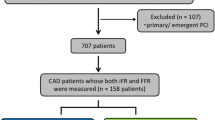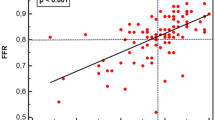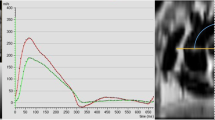Abstract
In recent studies it has been demonstrated that a reduced coronary flow reserve (CFR) is independently associated with a less benign long-term outcome. Aortic stiffness is one of the most important cardiovascular risk factors predicting cardiovascular morbidity and mortality. Vasodilator stress transesophageal echocardiography (TEE) is a suitable method to evaluate simultaneously CFR and elastic properties of the descending thoracic aorta. The aim of the present study was to assess the relative prognostic value of simultaneously measured CFR and aortic elastic properties by pulsed-wave Doppler TEE in patients with suspected or known coronary artery disease (CAD). The study comprised 157 in-hospital patients with chest pain. In all patients, stress TEE was used for the simultaneous evaluation of CFR and aortic distensibility indices [elastic modulus E(p) and Young’s circumferential static elastic modulus E(s)]. During a mean follow-up of 48 ± 8 months, 13 patients suffered cardiovascular death. By univariate analysis older age, diabetes mellitus, increased left ventricular (LV) end-diastolic diameter, increased LV mass index, lower LV ejection fraction, and lower CFR were significant predictors of cardiovascular survival. Multivariate regression analysis showed that only CFR (hazard ratio [HR] 10.31, P = 0.04), age (HR 1.20, P = 0.001), and increased left ventricular (LV) end-diastolic diameter (HR 1.14, P = 0.02) were independent predictors of cardiovascular survival. Only in the small number of patients without CAD and abnormal CFR aortic distensibility seemed to provide complementary prognostic information over CFR. In the majority of patients aortic distensibility did not offer complementary prognostic information to CFR during vasodilator stress TEE testing.
Similar content being viewed by others
References
Rigo F, Gherardi S, Galderisi M, Pratali L, Cortigiani L, Sicari R, Picano E (2006) The prognostic impact of coronary flow-reserve assessed by Doppler echocardiography in non-ischaemic dilated cardiomyopathy. Eur Heart J 27:1319–1323
Iliceto S, Marangelli V, Memmola C, Rizzon P (1991) Transesophageal Doppler echocardiography evaluation of coronary blood flow velocity in baseline conditions and during dipyridamole-induced coronary vasodilation. Circulation 83:61–69
Sekine T, Daimon M, Hasegawa R, Teramoto K, Kawata T, Tanaka N, Takei Y, Takazawa K, Yoshida K, Komuro I (2006) Cibenzoline improves coronary flow velocity reserve in patients with hypertrophic obstructive cardiomyopathy. Heart Vessels 21:350–355
Takagi A, Tsurumi Y, Ishizuka N, Omori H, Arai K, Hagiwara N, Kasanuki H (2006) Single administration of cerivastatin, an HMG-CoA reductase inhibitor improves the coronary flow velocity reserve: a transthoracic echocardiographic study. Heart Vessels 21:298–301
Nemes A, Forster T, Kovacs Z, Csanady M (2006) Is the coronary flow velocity reserve improvement after aortic valve replacement for aortic stenosis transient? Results of a 3-year follow-up. Heart Vessels 21:157–161
Rigo F, Cortigiani L, Pasanisi E, Richieri M, Cutaia V, Celestre M, Raviele A, Picano E (2006) The additional prognostic value of coronary flow reserve on left anterior descending artery in patients with negative stress echo by wall motion criteria. A Transthoracic Vasodilator Stress Echocardiography Study. Am Heart J 151:124–130
Lowenstein J, Tiano C, Marquez G, Presti C, Quiroz C (2003) Simultaneous analysis of wall motion and coronary flow reserve of the left anterior descending coronary artery by transthoracic Doppler echocardiography during dipyridamole stress echocardiography. J Am Soc Echocardiogr 16:607–613
Nohtomi Y, Takeuchi M, Nagasawa K, Arimura K, Miyata K, Kuwata K, Yamawaki T, Kondo S, Yamada A, Okamatsu S (2003) Simultaneous assessment of wall motion and coronary flow velocity in the left anterior descending coronary artery during dipyridamole stress echocardiography. J Am Soc Echocardiogr 16:457–463
Chirillo F, Bruni A, De Leo A, Olivari Z, Franceschini-Grisolia E, Totis O, Stritoni P (2004) Usefulness of dipyridamole stress echocardiography for predicting graft patency after coronary artery bypass grafting. Am J Cardiol 93:24–30
Laurent S, Boutouyrie P, Asmar R, Gautier I, Laloux B, Guize L, Ducimetiere P, Benetos A (2001) Aortic stiffness is an independent predictor of all-cause and cardiovascular mortality in hypertensive patients. Hypertension 37:1236–1241
Boutouyrie P, Tropeano AI, Asmar R, Gautier I, Benetos A, Lacolley P, Laurent S (2002) Aortic stiffness is an independent predictor of primary coronary events in hypertensive patients: a longitudinal study. Hypertension 39:10–15
Peterson L, Jensen R, Parnell R (1960) Mechanical properties of arteries in vivo. Circ Res 8:622–639
Nichols W, O’Rourke M (1989) Properties of the arterial wall. In: Nichols W, O’Rourke M (eds) McDonald’s blood flow in arteries. Lea & Febiger, Philadelphia, pp 77–124
Nemes A, Forster T, Gruber N, Csanady M (2004) Coronary flow velocity reserve and indices describing aortic distensibility in patients after coronary angiography. Int J Cardiol 96:29–33
Nemes A, Forster T, Csanady M (2004) Decreased aortic distensibility and coronary flow velocity reserve in patients with significant aortic valve stenosis with normal epicardial coronary arteries. J Heart Valve Dis 13:567–573
Nemes A, Forster T, Csanady M, Gruber N (2004) Indices of aortic distensibility and coronary flow velocity reserve in patients with different grades of aortic atherosclerosis. Int J Cardiovasc Imaging 20:271–277
Nemes A, Forster T, Csanady M (2006) Relationship between coronary flow velocity reserve and aortic stiffness. Am J Physiol Heart Circ Physiol 290:H1311
Nemes A, Forster T, Csanady M (2007) Impaired coronary flow velocity reserve and aortic distensibility in patients with untreated hypercholesterolemia-an echocardiographic study. Int J Cardiovasc Imaging 23:15–23
Nemes A, Forster T, Csanady M (2007) Reduced aortic distensibility and coronary flow velocity reserve in diabetes mellitus patients with a negative coronary angiogram. Can J Cardiol 23:445–450
Nemes A, Forster T, Csanady M (2007) Simultaneous evaluation of coronary flow velocity reserve and aortic distensibility indices in hypertension. Heart Vessels 22:73–78
Dunstan DW, Zimmet PZ, Welborn TA, De Courten MP, Cameron AJ, Sicree RA, Dwyer T, Colagiuri S, Jolley D, Knuiman M, Atkins R, Shaw JE (2002) The rising prevalence of diabetes and impaired glucose tolerance: the Australian Diabetes, Obesity and Lifestyle Study. Diabetes Care 25:829–834
Lang RM, Bierig M, Devereux RB, Flachskampf FA, Foster E, Pellikka PA, Picard MH, Roman MJ, Seward J, Shanewise JS, Solomon SD, Spencer KT, Sutton MS, Stewart WJ (2005) Chamber Quantification Writing Group; American Society of Echocardiography’s Guidelines and Standards Committee; European Association of Echocardiography. Recommendations for chamber quantification: a report from the American Society of Echocardiography’s Guidelines and Standards Committee and the Chamber Quantification Writing Group, developed in conjunction with the European Association of Echocardiography, a branch of the European Society of Cardiology. J Am Soc Echocardiogr 18:1440–1463
Neglia D, Michelassi C, Trivieri MG, Sambuceti G, Giorgetti A, Pratali L, Gallopin M, Salvadori P, Sorace O, Carpeggiani C, Poddighe R, L’Abbate A, Parodi O (2002) Prognostic role of myocardial blood flow impairment in idiopathic left ventricular dysfunction. Circulation 105:186–193
Albertal M, Voskuil M, Piek JJ, de Bruyne B, Van Langenhove G, Kay PI, Costa MA, Boersma E, Beijsterveldt T, Sousa JE, Belardi JA, Serruys PW (2002) Coronary flow velocity reserve after percutaneous interventions is predictive of periprocedural outcome. Circulation 105:1573–1578
Kingwell BA, Waddell TK, Medley TL, Cameron JD, Dart AM (2002) Large artery stiffness predicts ischemic threshold in patients with coronary artery disease. J Am Coll Cardiol 40:773–779
Cruickshank K, Riste L, Anderson SG, Wright JS, Dunn G, Gosling RG (2002) Aortic pulse-wave velocity and its relationship to mortality in diabetes and glucose intolerance: an integrated index of vascular function? Circulation 106:2085–2090
Blacher J, Safar ME, Guerin AP, Pannier B, Marchais SJ, London GM (2003) Aortic pulse wave velocity index and mortality in end-stage renal disease. Kidney Int 63:1852–1860
Meaume S, Benetos A, Henry OF, Rudnichi A, Safar ME (2001) Aortic pulse wave velocity predicts cardiovascular mortality in subjects >70 years of age. Arterioscler Thromb Vasc Biol 21:2046–2050
Sutton-Tyrrell K, Najjar SS, Boudreau RM, Venkitachalam L, Kupelian V, Simonsick EM, Havlik R, Lakatta EG, Spurgeon H, Kritchevsky S, Pahor M, Bauer D, Newman A (2005) Elevated aortic pulse wave velocity, a marker of arterial stiffness, predicts cardiovascular events in well-functioning older adults. Circulation 111:3384–3390
Willum-Hansen T, Staessen JA, Torp-Pedersen C, Rasmussen S, Thijs L, Ibsen H, Jeppesen J (2006) Prognostic value of aortic pulse wave velocity as index of arterial stiffness in the general population. Circulation 113:664–670
Mattace-Raso FU, van der Cammen TJ, Hofman A, van Popele NM, Bos ML, Schalekamp MA, Asmar R, Reneman RS, Hoeks AP, Breteler MM, Witteman JC (2006) Arterial stiffness and risk of coronary heart disease and stroke: the Rotterdam Study. Circulation 113:657–663
Wang GH, Hu DY (2005) Effect of pulse wave velocity on coronary flow reserve in patients with essential hypertension. Zhonghua Yi Xue Za Zhi 85:54–57
Fukuda D, Yoshiyama M, Shimada K, Yamashita H, Ehara S, Nakamura Y, Kamimori K, Tanaka A, Kawarabayashi T, Yoshikawa J (2006) Relation between aortic stiffness and coronary flow reserve in patients with coronary artery disease. Heart 92:759–762
Leung MC, Meredith IT, Cameron JD (2006) Aortic stiffness affects the coronary blood flow response to percutaneous coronary intervention. Am J Physiol Heart Circ Physiol 290:H624–H630
Chamuleau SA, Tio RA, de Cock CC, de Muinck ED, Pijls NH, van Eck-Smit BL, Koch KT, Meuwissen M, Dijkgraaf MG, de Jong A, Verberne HJ, van Liebergen RA, Laarman GJ, Tijssen JG, Piek JJ (2002) Prognostic value of coronary blood flow velocity and myocardial perfusion in intermediate coronary narrowings and multivessel disease. J Am Coll Cardiol 39:852–858
Lim HE, Shim WJ, Rhee H, Kim SM, Hwang GS, Kim YH, Seo HS, Oh DJ, Ro YM (2000) Assessment of coronary flow reserve with transthoracic Doppler echocardiography: comparison among adenosine, standard-dose dipyridamole, and high-dose dipyridamole. J Am Soc Echocardiogr 13:264–270
Nemes A, Forster T, Palinkas A, Vass A, Borthaiser A, Ungi I, Thury A, Litvai E, Nadaskay M, Csanady M (2000) A dipyridamolterheléses transoesophagealis echokardiográfia segítségével számított coronaria-áramlási rezerv klinikai értéke ischaemiás szívbetegségben. Orv Hetil 141:2327–2331
Author information
Authors and Affiliations
Corresponding author
Rights and permissions
About this article
Cite this article
Nemes, A., Forster, T., Geleijnse, M.L. et al. Prognostic value of coronary flow reserve and aortic distensibility indices in patients with suspected coronary artery disease. Heart Vessels 23, 167–173 (2008). https://doi.org/10.1007/s00380-007-1026-5
Received:
Accepted:
Published:
Issue Date:
DOI: https://doi.org/10.1007/s00380-007-1026-5




